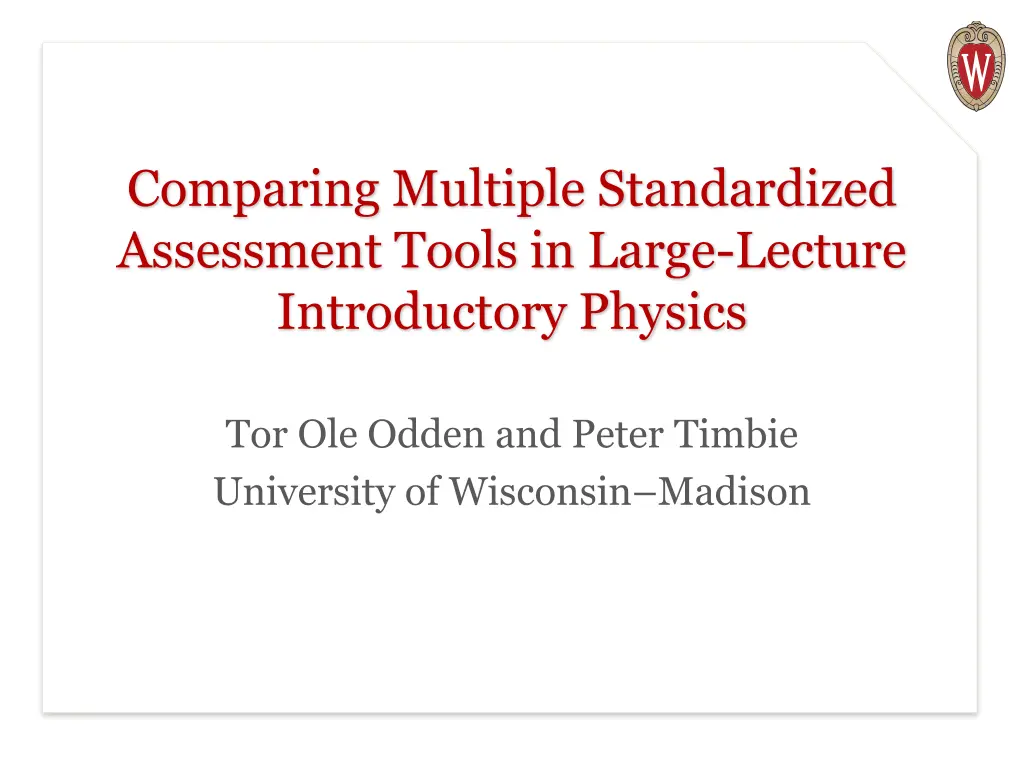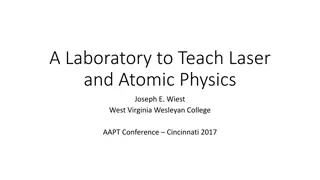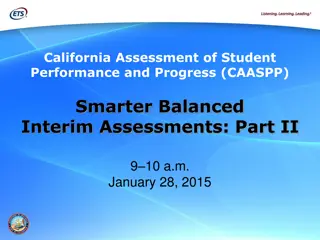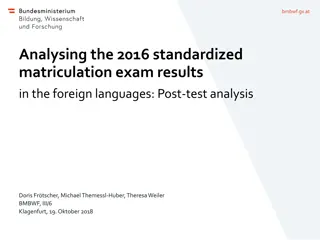
Comparing Standardized Assessment Tools in Large Introductory Physics Classes
"Explore a study conducted at the University of Wisconsin-Madison comparing multiple standardized assessment tools in large lecture introductory physics classes. The research focuses on evaluating problem-solving assessments and their implementation in different course sequences. Discover the results and correlations between assessments, grades, and final exam scores."
Uploaded on | 0 Views
Download Presentation

Please find below an Image/Link to download the presentation.
The content on the website is provided AS IS for your information and personal use only. It may not be sold, licensed, or shared on other websites without obtaining consent from the author. If you encounter any issues during the download, it is possible that the publisher has removed the file from their server.
You are allowed to download the files provided on this website for personal or commercial use, subject to the condition that they are used lawfully. All files are the property of their respective owners.
The content on the website is provided AS IS for your information and personal use only. It may not be sold, licensed, or shared on other websites without obtaining consent from the author.
E N D
Presentation Transcript
Comparing Multiple Standardized Assessment Tools in Large-Lecture Introductory Physics Tor Ole Odden and Peter Timbie University of Wisconsin Madison
Setting The University of Wisconsin Madison has 4 introductory course sequences: General algebra-based physics ( > 900 students/semester) Calc-based physics for engineers ( > 700 students/semester) Calc-based physics for life science majors ( > 400 students/semester) Calc-based physics for physics majors (~75 students/year) Instructors change each semester UNIVERSITY OF WISCONSIN 2
Goal Looking for longitudinal course evaluation UW has used Force Concept Inventory for most of the 2000s. However, Difficult to implement (pre/post) We wanted to test problem-solving Assessment in E&M During 2013-2014, we tested several different assessment tools, looking for Reliable Implementable Problem-solving based UNIVERSITY OF WISCONSIN 3
The Assessments The Mechanics Baseline Test (Hestenes and Wells, 1992) Multiple Choice 26 Questions The Conceptual Survey of Electricity and Magnetism (Maloney, O Kuma, Hieggelke, & Van Heuvelen, 2001) Multiple Choice 32 questions The Survey Instrument (Marx & Cummings, 2010) Problem solving 13 questions UNIVERSITY OF WISCONSIN 4
Implementation Assessments were given at the beginning of lab 95 99% participation for assessments at the beginning of lab 66% 87% participation for end of lab Mechanics Baseline Test and Conceptual Survey of E&M graded via scantron Students graded own Survey Instruments UNIVERSITY OF WISCONSIN 5
Evaluating Assessments Course grade/score correlation Final exam grade/score correlation Reliability coefficients (Cronbach s Alpha) Survey Instrument/Conceptual Survey of E&M correlations UNIVERSITY OF WISCONSIN 6
Results MBT Scores vs Grades (Algebra-Based Mechanics, Fall 2013) 100 MBT Score (%) 80 60 40 20 0 0 20 40 Grade (%) 60 80 100 Pearson Correlation Coefficient r = 0.36, p < .001, N = 472. Average MBT Score = 38%. = 0.63 UNIVERSITY OF WISCONSIN 7
Results Continued MBT Scores vs Grades (Algebra-Based Mechanics, Spring 2014) 100 MBT Score (%) 80 60 40 20 0 0 20 40 60 80 100 Averaged Exam Scores (%) Pearson Correlation Coefficient r = 0.56, p < .001, N = 392. Average MBT score = 45%. = 0.67 UNIVERSITY OF WISCONSIN 8
Results Continued SI Scores vs Grades (Calc-Based Mechanics, Fall 2013) 100 80 SI Score (%) 60 40 20 0 0 20 40 Grade (%) 60 80 100 Pearson Correlation Coefficient r = 0.65, p < .001, N = 244. Average SI score = 43%. UNIVERSITY OF WISCONSIN 9
Results Continued CSEM Scores vs Grades (Calc-based E&M, Spring 2014) 100 CSEM Score (%) 80 60 40 20 0 0.00 1.00 2.00 3.00 4.00 5.00 Grade (Grade Points) Pearson Correlation Coefficient r = 0.70, p < .001, N = 249, Average CSEM Score = 51%. = 0.83 UNIVERSITY OF WISCONSIN 10
Results Continued CSEM Score vs SI Score 100 CSEM Score (%) 80 60 40 20 0 0 20 40 SI Score (%) 60 80 100 Pearson Correlation Coefficient r = 0.61, p < .001, N = 160. Average CSEM = 50%, Average SI = 43%. UNIVERSITY OF WISCONSIN 11
Conclusions Conceptual Survey of E&M most reliable and highly correlated with course grades for calc-based intro physics Survey Instrument had strong positive relationship with both course grades and CSEM Mechanics Baseline Test had weakest grade/score correlations .36 < r < .56 Reliability (Cronbach s Alpha) ranged from 0.63 0.67 for MBT, 0.61 0.83 for CSEM UNIVERSITY OF WISCONSIN 12
Going Forward No longer use Force Concept Inventory Mechanics baseline test for algebra-based mechanics Survey Instrument for calc-based mechanics Conceptual Survey of E&M for algebra-based E&M, calc-based E&M UNIVERSITY OF WISCONSIN 13
Questions? UNIVERSITY OF WISCONSIN 14
References Hestenes, D., & Wells, M. (1992). A mechanics baseline test. The Physics Teacher, 30(3), 159. Maloney, D. P., O Kuma, T. L., Hieggelke, C. J., & Van Heuvelen, A. (2001). Surveying students conceptual knowledge of electricity and magnetism. American Journal of Physics, 69(S1), S12. Marx, J., & Cummings, K. (2010). Development of a Survey Instrument to Gauge Students Problem Solving Abilities. AIP Conference Proceedings, 1289, 221 224. UNIVERSITY OF WISCONSIN 15






















